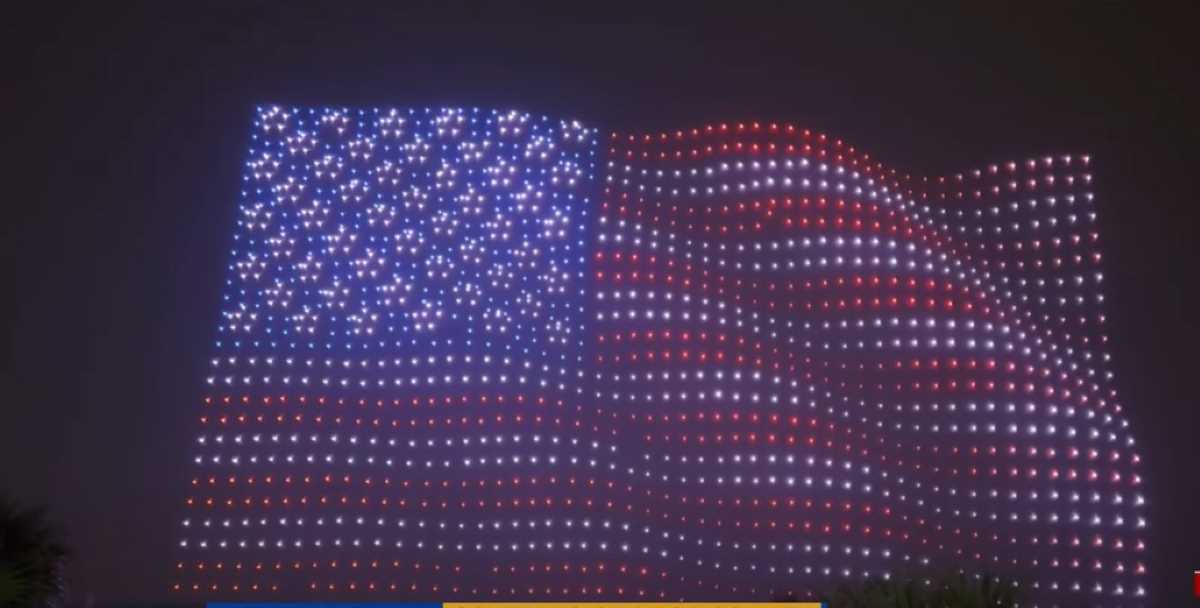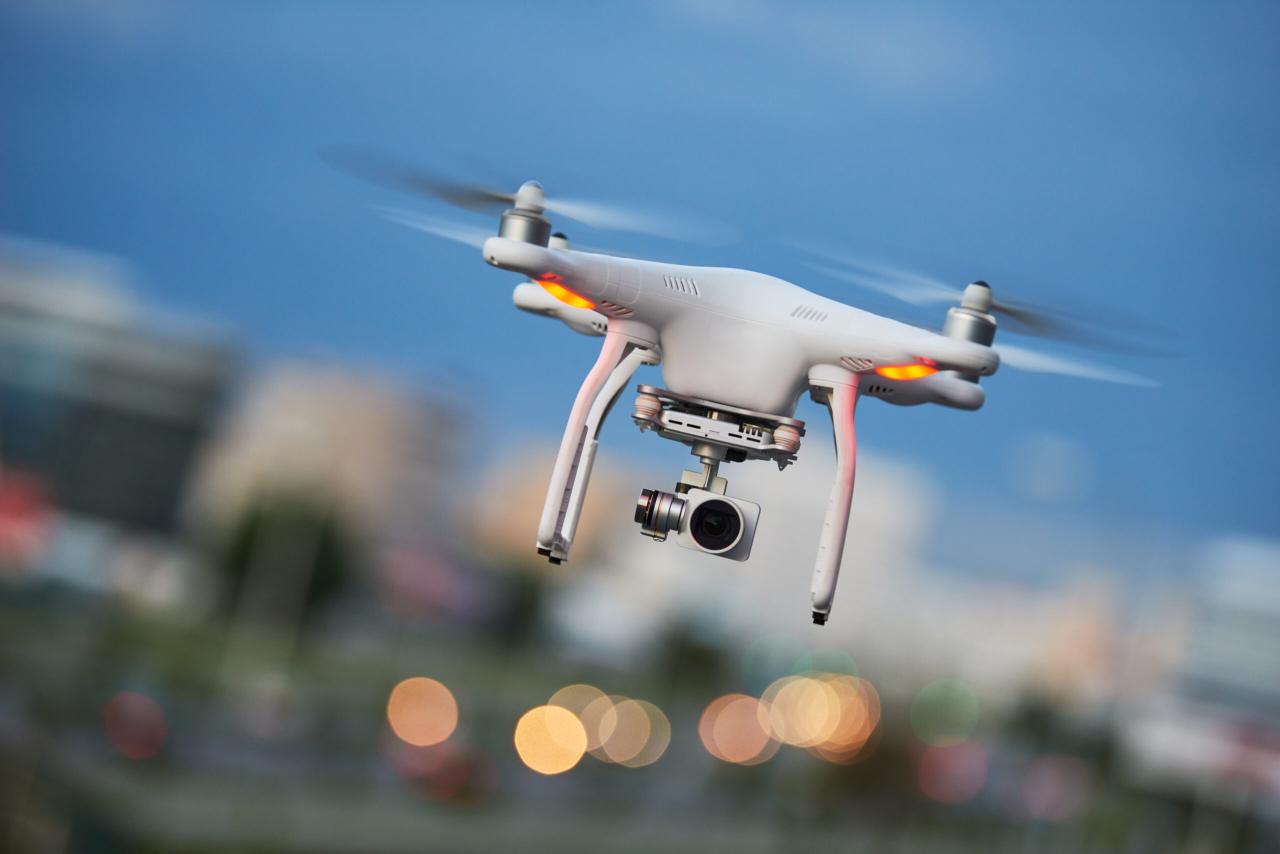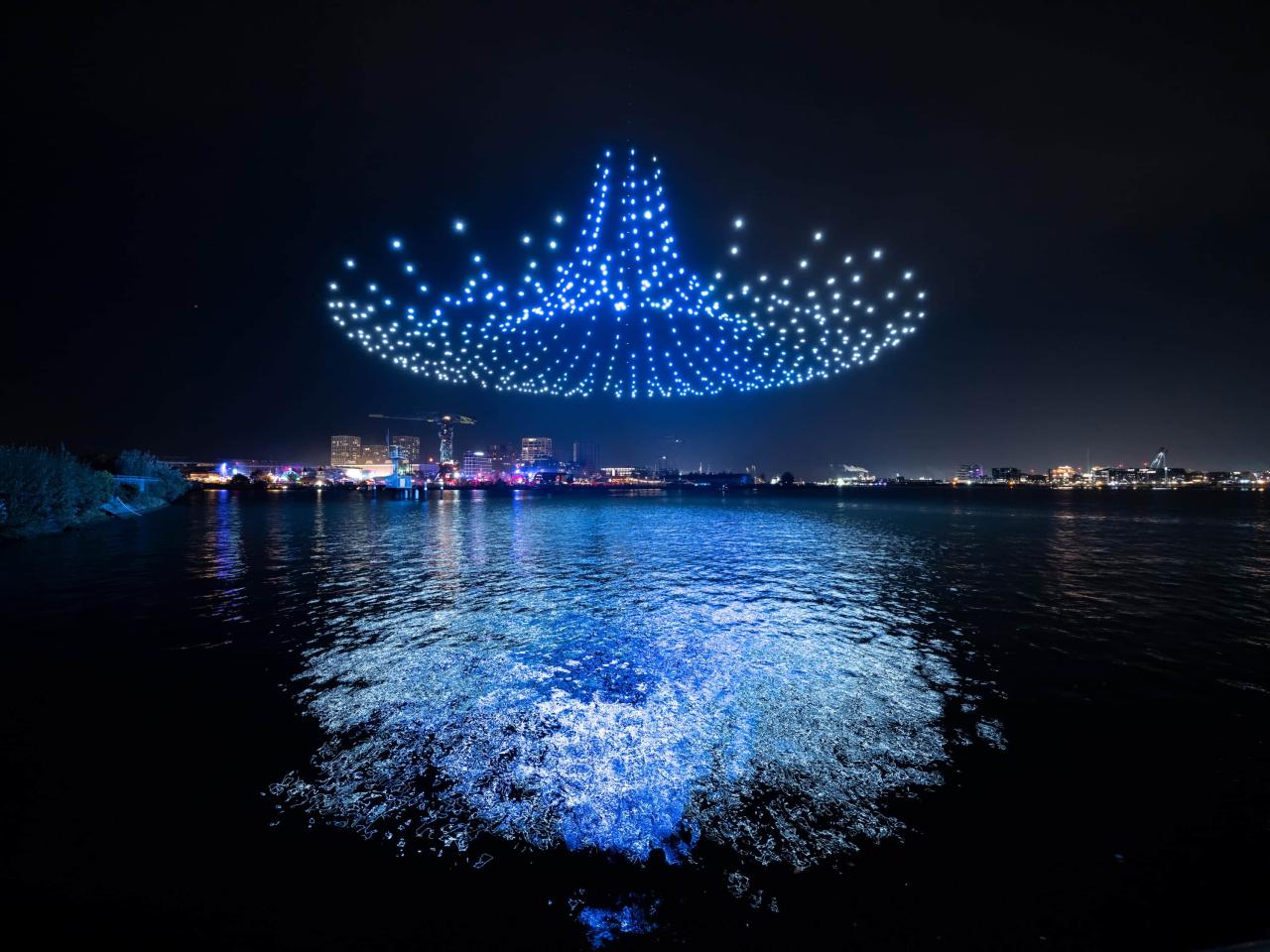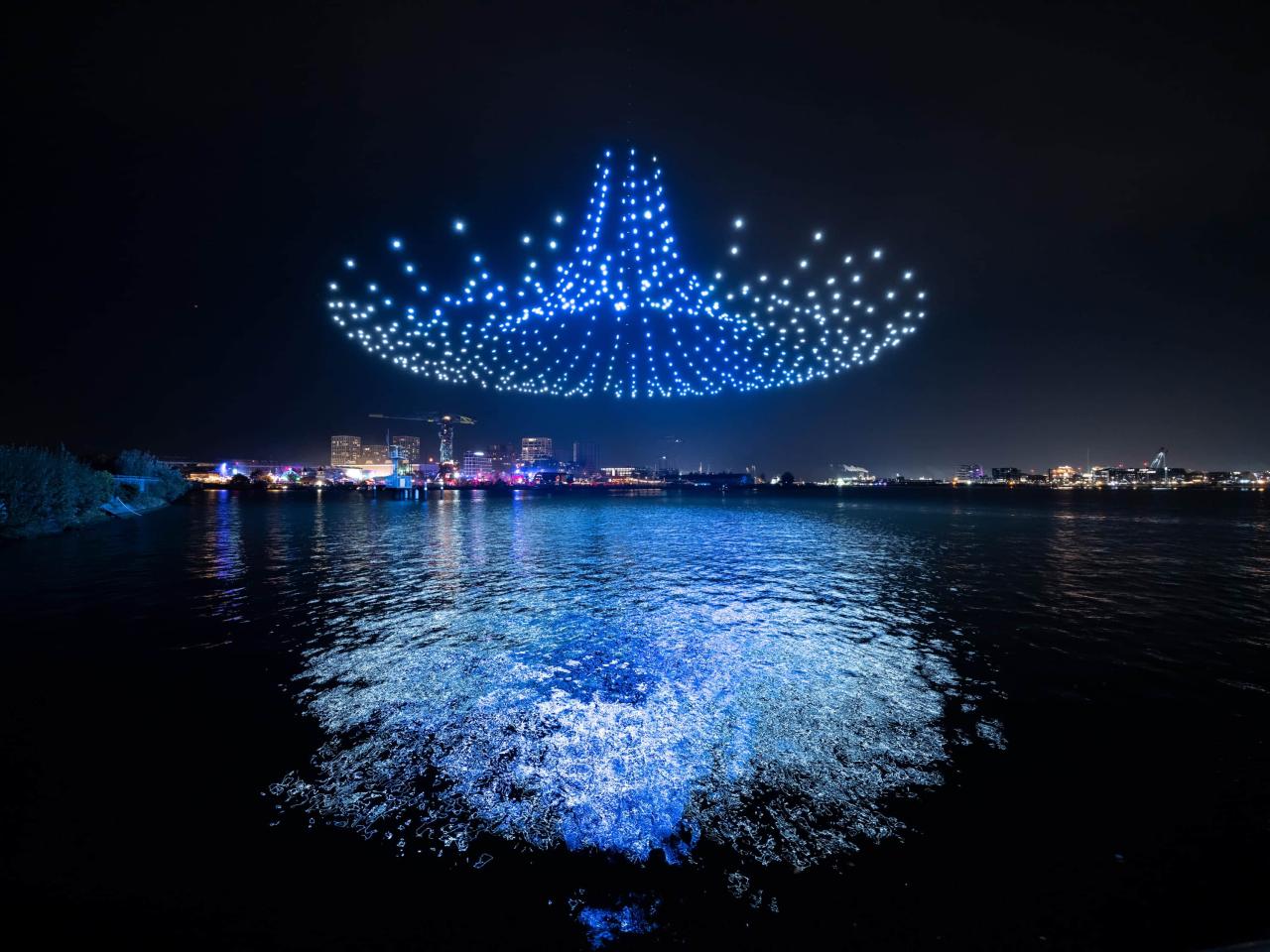Florida Drone Show: Get ready for a breathtaking spectacle! This guide dives deep into the world of Florida’s captivating drone shows, exploring everything from the dazzling displays themselves to the regulations, locations, and economic impact they create. We’ll cover the technology behind these mesmerizing performances, the environmental considerations, and even offer some insider tips to make your experience unforgettable.
From the permits needed to the stunning locations across the Sunshine State, we’ll illuminate the fascinating process of bringing these aerial masterpieces to life. Whether you’re a drone enthusiast, a potential organizer, or simply a curious spectator, this guide will equip you with the knowledge to appreciate the magic and complexity behind Florida’s drone shows.
Florida Drone Show Regulations and Permits
Navigating the regulatory landscape for drone shows in Florida requires understanding permit processes, airspace restrictions, and county-specific rules. This section provides a clear overview to help you plan your drone show successfully and legally.
Obtaining Permits for Drone Shows in Florida

Securing the necessary permits for a drone show in Florida involves several steps. First, you must contact the Federal Aviation Administration (FAA) to register your drones and obtain the necessary waivers or authorizations for operating beyond visual line of sight (BVLOS) and in controlled airspace. Next, you need to apply for permits with the relevant local authorities, which vary depending on the location and scale of your show.
Florida drone shows are becoming increasingly popular, offering spectacular nighttime displays. However, safety is paramount, as highlighted by a recent incident; check out this report on the orlando drone show accident to understand potential risks. Learning from such events helps ensure future Florida drone shows remain safe and awe-inspiring.
This usually involves submitting a detailed flight plan, outlining the show’s timeline, drone specifications, and safety measures. Expect thorough reviews and potential site inspections before approval.
Airspace Usage Regulations for Drone Shows
Florida’s airspace regulations for drone shows are stringent, prioritizing safety and preventing conflicts with manned aircraft. The FAA has designated specific airspace classes, each with different operational restrictions. Drone shows often require authorization to operate in controlled airspace near airports or other sensitive areas. Furthermore, you must maintain a safe distance from other aircraft and adhere to altitude limitations.
Understanding these regulations is critical for preventing legal issues and ensuring the safety of both the drones and the public.
Comparison of Permit Requirements Across Florida Counties
Permit requirements for drone shows can vary significantly across Florida’s diverse counties. Some counties might have streamlined processes, while others may have more stringent regulations. Factors like population density, proximity to airports, and local ordinances influence these differences. It’s crucial to research the specific requirements for the chosen county well in advance to avoid delays and potential complications.
Key Permit Requirements Summary
| County | FAA Authorization | Local Permit | Insurance Requirements |
|---|---|---|---|
| Example County A | Part 107 Waiver (likely required) | Special Event Permit | $1M liability insurance |
| Example County B | Part 107 Waiver & COA (Certificate of Authorization, potentially) | Film Permit | $2M liability insurance |
| Example County C | Part 107, potentially LAANC authorization | Public Assembly Permit | $500,000 liability insurance |
Popular Florida Drone Show Locations
Choosing the right location is vital for a successful drone show. Factors like accessibility, airspace considerations, and scenic backdrops all play a significant role. Below are five popular locations in Florida, each offering unique advantages.
- Location 1 (Example: St. Augustine): Historic setting, ample open space, potential for showcasing the city’s architecture. Capacity: Medium. Restrictions: Proximity to historical sites may require special considerations.
- Location 2 (Example: Clearwater Beach): Stunning beach backdrop, large open area, excellent for evening shows. Capacity: Large. Restrictions: Potential for wind and weather disruptions.
- Location 3 (Example: Kennedy Space Center): Unique backdrop, potential for themed shows related to space exploration. Capacity: Medium-Large. Restrictions: Strict airspace regulations and security protocols.
- Location 4 (Example: Everglades National Park): Natural setting, diverse landscape, opportunities for creative choreography. Capacity: Medium. Restrictions: Environmental regulations and permitting requirements.
- Location 5 (Example: Orlando): Large open spaces, good infrastructure, proximity to entertainment venues. Capacity: Large. Restrictions: Potential for airspace congestion and competition for permits.
Map Description: A map of Florida would illustrate the geographical distribution of these locations. The map would use distinct markers to represent each location, color-coded for easy identification. A legend would clearly label each location with its name. The map would emphasize the varied geographical spread of potential drone show locations across the state, from coastal areas to inland locations.
Types of Drone Shows in Florida
Florida’s drone show landscape is diverse, encompassing various types of shows catering to different audiences and purposes. This section explores the different types, their unique characteristics, and the logistical considerations involved.
Examples of Drone Show Types
Florida hosts a wide array of drone shows. Themed shows, such as those celebrating holidays or commemorating historical events, often attract large crowds. Artistic performances, using drones to create mesmerizing light displays synchronized with music, are becoming increasingly popular. Commercial events, such as product launches or corporate celebrations, also leverage the visual impact of drone shows.
Comparison of Drone Show Types
| Show Type | Size/Scale | Complexity | Target Audience |
|---|---|---|---|
| Themed Show (e.g., Holiday Show) | Large | High (complex choreography) | General public, families |
| Artistic Performance | Medium-Large | High (requires precise synchronization) | Art enthusiasts, general public |
| Commercial Event | Small-Medium | Medium (focused message, simple choreography) | Specific target audience (clients, investors) |
Technological Aspects of Florida Drone Shows
Large-scale drone shows rely on sophisticated technology for synchronization, safety, and spectacular visual effects. Understanding these aspects is crucial for organizers and enthusiasts alike.
Technology Used in Drone Shows
Orchestrating a large-scale drone show involves specialized software for flight planning and control, high-performance drones equipped with bright LEDs, and robust communication protocols to ensure seamless synchronization. Software packages allow choreographers to design intricate flight patterns, simulating the show before execution. Real-time monitoring systems track drone positions and battery levels, providing crucial data for safety management.
Florida drone shows are becoming increasingly popular, offering spectacular nighttime displays. However, it’s crucial to remember the potential risks; check out this report on a drone show accident to understand the importance of safety protocols. Understanding these risks helps ensure future Florida drone shows remain both breathtaking and safe.
Programming and Choreographing Drone Flights
Programming drone flight patterns involves creating detailed 3D models of the show’s airspace and defining the trajectory of each drone. Sophisticated software allows for precise control over individual drone movements, enabling complex formations and dynamic light displays. The process involves meticulous planning, testing, and refinement to ensure a seamless and visually stunning performance.
Safety Measures During Drone Shows, Florida drone show
Safety is paramount in drone shows. Multiple layers of redundancy are built into the systems, including backup communication channels and emergency landing protocols. Trained personnel constantly monitor drone status and weather conditions, ready to intervene if necessary. Geofencing technology restricts drone operation to designated areas, preventing accidental flights outside the show’s boundaries.
Impact of Weather Conditions
Weather significantly impacts drone show planning and execution. High winds, heavy rain, or low visibility can lead to cancellations or delays. Organizers use weather forecasting tools to assess risk and implement contingency plans, ensuring the safety of the drones and the public. Real-time weather monitoring allows for adaptive decision-making during the show itself.
Economic Impact of Florida Drone Shows
Drone shows contribute significantly to Florida’s economy, boosting tourism, creating jobs, and generating revenue for various businesses. This section explores the economic benefits.
Economic Benefits of Drone Shows
Drone shows attract tourists, stimulating spending in hotels, restaurants, and local businesses. They generate revenue for show organizers, drone operators, and supporting industries. Furthermore, the growing industry creates jobs in technology, event management, and related fields. The overall economic ripple effect extends beyond the immediate event, contributing to the state’s economic growth.
Revenue Streams Associated with Drone Shows
Revenue streams include ticket sales, sponsorships, advertising, merchandise sales, and fees from filming or broadcasting rights. Organizers can also generate revenue by providing drone show services to other events or businesses. The potential for profit depends on the show’s scale, location, and marketing efforts.
Job Creation Opportunities

The drone show industry creates numerous jobs, including drone pilots, programmers, choreographers, technicians, event managers, and marketing professionals. As the industry expands, the demand for skilled professionals will continue to grow, providing significant employment opportunities in Florida.
Potential Economic Impacts by Industry
| Industry | Economic Impact | Example | Quantifiable Metric (Example) |
|---|---|---|---|
| Tourism | Increased tourist spending | Hotel bookings, restaurant revenue | Increase in hotel occupancy rate by 15% during show week |
| Event Management | Job creation, revenue from event services | Event planning, logistics, security | Creation of 50 temporary jobs per show |
| Technology | Revenue from drone sales, software, and maintenance | Drone manufacturers, software developers | $1M in drone-related sales in a year |
Environmental Considerations of Florida Drone Shows
While spectacular, drone shows must consider their environmental impact. This section addresses potential negative effects and strategies for mitigation.
Potential Environmental Impacts
Noise and light pollution are the primary environmental concerns associated with drone shows. Loud drone motors can disturb wildlife and nearby residents, while bright LED lights can disrupt nocturnal ecosystems. Careful planning and responsible practices are necessary to minimize these impacts.
Mitigation Strategies
Strategies include using quieter drones, optimizing light levels to reduce light pollution, selecting show times that minimize disruption to wildlife, and conducting thorough environmental impact assessments before staging a show. Collaborating with local environmental agencies can help ensure responsible practices.
Regulatory Framework
Florida’s environmental regulations apply to drone shows, requiring organizers to comply with noise ordinances, light pollution limits, and other relevant laws. Obtaining necessary permits and adhering to these regulations is crucial for avoiding penalties and ensuring environmental protection.
Environmentally Responsible Practices
Examples of environmentally responsible practices include using eco-friendly drones, minimizing energy consumption, recycling show materials, and supporting local conservation efforts. Organizers can also offset their carbon footprint through carbon offset programs.
Final Wrap-Up

Florida drone shows are more than just dazzling displays; they’re a testament to technological innovation, artistic expression, and economic potential. From the meticulous planning and intricate choreography to the breathtaking visuals that captivate audiences, these events represent a vibrant intersection of technology, entertainment, and tourism. This guide has explored the multifaceted world of Florida drone shows, providing a comprehensive overview of the regulations, locations, types, technology, economic impact, and environmental considerations involved.
Whether you’re planning a show, attending one, or simply curious about this exciting field, we hope this information has been both informative and inspiring.
Top FAQs
What types of drones are typically used in Florida drone shows?
Shows usually utilize multiple, smaller, specialized drones designed for synchronized flight and equipped with bright LEDs for visual effects.
Florida drone shows are getting increasingly popular, offering dazzling light displays. If you’re looking for top-notch drone technology to create these amazing spectacles, check out the innovative drones from sky elements drones ; their capabilities are seriously impressive. Seeing their work would definitely elevate any Florida drone show to the next level!
How much does it cost to put on a Florida drone show?
Costs vary greatly depending on the show’s scale, duration, complexity, and number of drones involved. Expect significant expenses for permits, drone equipment, software, programming, and crew.
Are there any age restrictions for attending a drone show?
Age restrictions depend on the specific event and venue. Some may be family-friendly, while others might have age recommendations or restrictions based on the content or location.
How long do Florida drone shows typically last?
Show durations vary, but many range from 10-20 minutes, though some may be longer or shorter depending on the production.
